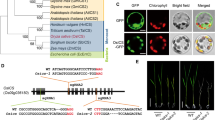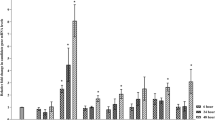Abstract
In angiosperms the interactions between the secretory matrix of the stylar transmitting tract and the growing pollen tubes have central roles in determining a successful fertilization. Sp41 is a major glycosylated component of the soluble proteins of the transmitting tract matrix and exhibits (1–3)-β-glucanase activity. It is a member of the pathogenesis-related protein superfamily, but shows developmental regulation as opposed to pathogen induction. In order to investigate the mechanisms regulating Sp41 expression, we isolated and characterized genomic clones corresponding to the sp41 a gene. Sp41 a contains an intervening sequence localized between the sequences encoding for a putative signal peptide and the mature protein. A fragment of 2.5 kb that lies 5′ to the coding region of the gene was sufficient to confer transmitting tract specific expression to a β-glucuronidase reporter gene in transgenic tobacco plants. The sp41 transcripts have unusually long 5′-untranslated sequences. The leader sequences contain small open reading frames, include secondary structures, and may be involved in post-transcriptional regulation. A possible function for Sp41 in reproductive physiology was tested by monitoring tobacco plants transformed with antisense stylar sp41a RNA. Transgenic antisense plants with immunologically and enzymatically undetectable levels of (1–3)-β-glucanase were obtained and their offspring analyzed. The progeny plants did not show any detectable phenotypic modifications as they had a normal flower morphology and were fully fertile.
Similar content being viewed by others
References
An G: Binary Ti vectors for plant transformation and promoter analysis. Meth Enzymol 153: 292–305 (1987).
Ausubel FM, Brent R, Kingston RE, Moore DD, Smith JA, Seidman JG, Struhl K: Current Protocols in Molecular Biology. John Wiley, New York (1989).
Benfey PN, Chua NH: The Cauliflower Mosaic Virus 35S promoter: combinatorial regulation of transcription in plants. Science 250: 959–966 (1990).
Bucciaglia PA, Smith AG: Cloning and characterization of Tag 1, a tobacco anther β-1,3-glucanase expressed during tetrad dissolution. Plant Mol Biol 24: 903–914 (1994).
Budelier KA, Smith AG, Gasser CS: Regulation of a stylar transmitting tissue-specific gene in wild-type and transgenic tomato and tobacco. Mol Gen Genet 224: 183–192 (1990).
Castresana C, deCarvalho F, Gheysen G, Habets M, Inzé D, VanMontagu M: Tissue-specific and pathogen-induced regulation of a Nicotiana plumbaginifolia β-1,3-glucanase gene. Plant Cell 2: 1131–1143 (1990).
Chen C-G, Cornish EC, Clarke AE: Specific expression of an extensin-like gene in the style of Nicotiana alata. Plant Cell 4: 1053–1062 (1992).
Cheung AY, May B, Kawata EE, Gu Q, Wu H-M: Characterization of cDNAs for stylar transmitting tissue-specific proline-rich proteins in tobacco. Plant J 3: 151–160 (1993).
Cohen Y, Niderman T, Mösinger E, fluhr R: β-aminobutyric acid induces the accumulation of pathogenesis-related proteins in tomato (Lycopersicum esculentum L.) plants and resisntance to late blight infection caused by Phytophthora infestans. Plant Physiol 104: 59–66 (1994).
Coleman CE, Kao T-h: The flanking regions of two Petunia inflata S alleles are heterogeneous and contain repetitive sequences. Plant Mol Biol 18: 725–737 (1992).
DamianiJr RD, Wessler SR: An upstream open reading frame represses expression of Lc, a member of the R/B family of maize transcription activators. Proc Natl Acad Sci USA 90: 8244–8248 (1993).
Davies B, Schwarz-Sommer Z: Control of floral organ identity by homeotic MADS-box transcription factors. In: Nover L (ed) Plant Promoters and Transcription Factors, pp. 235–258. Springer-Verlag, Berlin/Heidelberg/New York (1994).
Devereux J, Haeberli P, Smithies O: A comprehensive set of sequence analysis programs for the VAX. Nucl Acids Res 12: 387–395 (1984).
Donald RGK, Cashmore AR: Mutation of either G box or I box sequences profoundly affects expression from the Arabidopsis rbcS-1A promoter. EMBO J 9: 1717–1726 (1990).
Dzelzkalns VA, Nasrallah JB, Nasrallah ME: Cell-cell communication in plants: self-incompatibility in flower development. Devel Biol 153: 70–82 (1992).
Dzelzkalns VA, Thorsness MK, dwyer KG, Baxter JS, Balent MA, Nasrallah ME, Nasrallah JB: Distinct cisacting elements direct pistil-specific and pollen-specific activity of the Brassica S locus glycoprotein gene promoter. Plant Cell 5: 855–863 (1993).
Eyal Y, Sagee O, Fluhr R: Dark-induced accumulation of a basic pathogenesis-related (PR-1) transcript and light requirement for its induction by ethylene. Plant Mol Biol 10: 589–599 (1992).
Fluhr R, Sessa G, Sharon A, Ori N, Lotan T: Pathogenesis-related proteins exhibit both pathogen-induced and developmental regulation. In: Advances in Molecular Genetics of Plant-Microbe Interactions, vol 1, pp. 387–394. Kluwer Academic Publishers, dordrecht, Netherlands (1991).
Forde BG: AT-rich elements (ATREs) in the promoter regions of nodulin and other higher plant genes: a novel class of cis-acting regulatory elements? In: Nover L (ed) Plant Promoters and Transcription Factors, pp. 87–103. Springer-Verlag, Berlin/Heidelberg/New York (1994).
Fütterer J, Gordon K, Sanfacon H, Bonneville J-M, Hohn T: Positive and negative control of translation by the leader sequence of cauliflower mosaic virus pregenomic 35S. EMBO J 9: 1697–1707 (1990).
Gallie DR, Sleat DE, Watts JW, Turner PC, Wilson TMA: The 5′-leader sequence of tobacco mosaic virus RNA enhances the expression of foreign gene transcripts in vitro and in vivo. Nucl Acids Res 15: 3257–3273 (1987).
Gasser CS, Robinson-Beers K: Pistil development. Plant Cell 5: 1231–1239 (1993).
Gheysen G, Inzé D, Soetaert P, VanMontagu M, Castresana C: Sequence of a Nicotiana plumbaginifolia β(1,3)-glucanase gene encoding a vacuolar isoform. Nucl Acids Res 18: 6685 (1990).
Gilmartin PM, Sarokin L, Memelink J, Chua NH: Molecular light switches for plant genes. Plant Cell 2: 369–378 (1990).
Hayes TE, Sengupta P, Cochran BH: The human c-fos serum response factor and the yeast factors GRM/PRTF have related DNA-binding specificities. Genes Devel 2: 1713–1722 (1988).
Heslop-Harrison J: Pollen germination and pollen-tube growth. Int Rev Cytol 107: 1–78 (1987).
Hinnebusch AG: Novel mechanisms of translational control in Saccharomyces cerevisiae. Trends Genet 4: 169–174 (1988).
Jansen MAK, Sessa G, Malkin S, Fluhr R: PEPC-mediated carbon fixation in transmitting tract cells reflects style-pollen tube interactions. Plant J 2: 507–515 (1992).
Jefferson RA, Kavanagh TA, Bevan MW: GUS fusions: β-glucuronidase as a sensitive and versatile gene fusion marker in higher plants. EMBO J 6: 3901–3907 (1987).
Joosten MHAJ, Bergmans CJB, Meulenhoff EJS, Cornelissen BJC, deWit PGJM: Purification and serological characterization of three basic 15-kilodalton pathogenesis-related proteins from tomato. Plant Physiol 94: 585–591 (1990).
Joshi CP: An inspection of the domain between putative TATA box and translation start site in 79 plant genes. Nucl Acids Res 15: 6643–6653 (1987).
Katagiri F, Lam E, Chua NH: Two tobacco DNA-binding proteins with homology to the nuclear factor CREB. Nature 340: 727–730 (1989).
Klarmann GJ, Schauber CA, Preston BD: Templatedirected pausing of DNA synthesis by HIV-1 reverse transcriptase during polymerization of HIV-1 sequences in vitro. J Biol Chem 268: 9793–9802 (1993).
Kozak M: Circumstances and mechanisms of inhibition of translation by secondary structure in eukaryotic mRNAs. Mol Cell Biol 9: 5134–5142 (1989).
Lee H-S, Huang S, Kao T-h: S proteins control rejection of incompatible pollen in Petunia inflata. Nature 367: 560–563 (1994).
Linthorst HJM, Melchers LS, Mayer A, vanRoekel JSC, Cornelissen BJC, Bol JF: Analysis of the gene families encoding acidic and basic β-1,3-glucanases of tobacco. Proc Natl Acad Sci USA 87: 8756–8760 (1990).
Lohmer S, Maddaloni M, Motto M, Salamini F, Thompson RD Transation of the mRNA of the maize transcriptional activator Opaque-2 is inhibited by upstream open reading frames present in the leader sequence. Plant Cell 5: 65–73 (1993).
Lord EM, Sanders LC: Roles for the extracellular matrix in plant development and pollination: a special case of cell movement in plants. Devel Biol 153: 16–28 (1992).
Lotan T, Ori N, Fluhr R: Pathogenesis-related proteins are developmentally regulated in tobacco flowers. Plant Cell 1: 881–887 (1989).
Lutcke HA, Chow KC, Mickel FS, Moss KA, Kern H, Scheele GA: Selection of AUG initiation codons differs in plants and animals. EMBO J 6: 43–48 (1987).
Malehorn DE, Scott KJ, Shah DM: Structure and expression of a barley acidic β-glucanase gene. Plant Mol Biol 22: 347–360 (1993).
Murfett J, Atherton TL, Mou B, Gasser CS, McClure BA. S-RNase expressed in transgenic Nicotiana causes S-allele-specific pollen rejection. Nature 367: 563–566 (1994).
Newbigin E, Anderson MA, Clarke AE: Gametophytic self-incompatibility systems. Plant Cell 5: 1315–1324 (1993).
Ori N, Sessa G, Lotan T, Himmelhoch S, Fluhr R: A major stylar matrix polypeptide (Sp41) is a member of the pathogenesis-related proteins superclass. EMBO J 9: 3429–3426 (1990).
Passmore S, Elble R, Tye BK: A protein involved in minichromosome maintenance in yeast binds a transcriptional enhancer conserved in eukaryotes. Genes Devel 3: 921–935 (1989).
Paulson JC: Glycoproteins: what are the sugar chains for? Trends Biochem Sci 14: 272–276 (1989).
Preissner KT: Structure and biological role of vitronectin. Annu Rev Cell Biol 7: 275–310 (1991).
Sanders LC, Lord EM: Directed movement of latex particles in the gynoecia of three species of flowering plants. Science 243: 1606–1608 (1989).
Sanders LC, Wang C-S, Walling L, Lord EM: A homolog of the substrate adhesion molecule vitronectin occurs in four species of flowering plants. Plant Cell 3: 629–635 (1991).
Schindler U, Cashmore AR: Photoregulated gene expression may involve ubiquitous DNA binding proteins. EMBO J 9: 3415–3427 (1990).
Shiraishi H, Okada K, Shimura Y: Nucleotide sequences recognized by the Agamous MADS domain of Arabidopsis thaliana in vitro. Plant J 4: 385–398 (1993).
Treisman R: The serum response element. Trends Biochem Sci 17: 423–426 (1992).
Vasil IK: Physiology and culture of pollen. Int Rev Cytol 107: 127–174 (1987).
Vögeli-Lange R, Fründt C, Hart CM, Beffa R, Nagy F, MeinsJr F: Evidence for a role of β-1,3-glucanase in dicot seed germination. Plant J 5: 273–278 (1994).
Wang H, Wu H-M, Cheung AY: Development and pollination regulated accumulation and glycosylation of a stylar transmitting tissue-specific proline-rich protein. Plant Cell 5: 1639–1650 (1993).
Wang C-S, Walling LL, Gu YQ, Ware CF, Lord EM: Two classes of proteins and mRNAs in Lilium longiflorum L. identified by human vitronectin probes. Plant Physiol 104: 711–717 (1994).
Worrall D, Hird DL, Hodge R, Paul W, Draper J, Scott R: Premature dissolution of the microsporocyte callose wall causes male sterility in transgenic tobacco. Plant Cell 4: 759–771 (1992).
Zhu J-K, Damsz B, Kononowicz AK, Bressan RA, Hasegawa PM: A higher plant extracellular vitronectin-like adhesion protein is related to the translational elongation factor-1α. Plant Cell 6: 393–404 (1994).
Author information
Authors and Affiliations
Rights and permissions
About this article
Cite this article
Sessa, G., Fluhr, R. The expression of an abundant transmitting tract-specific endoglucanase (Sp41) is promoter-dependent and not essential for the reproductive physiology of tobacco. Plant Mol Biol 29, 969–982 (1995). https://doi.org/10.1007/BF00014970
Received:
Accepted:
Issue Date:
DOI: https://doi.org/10.1007/BF00014970




